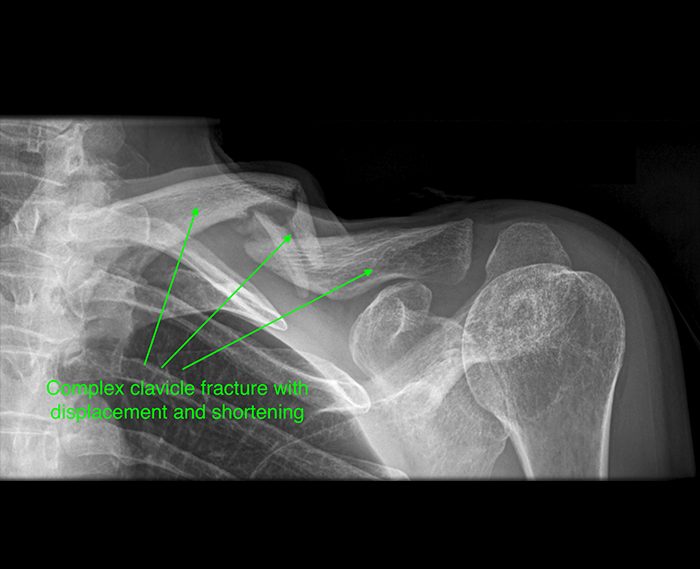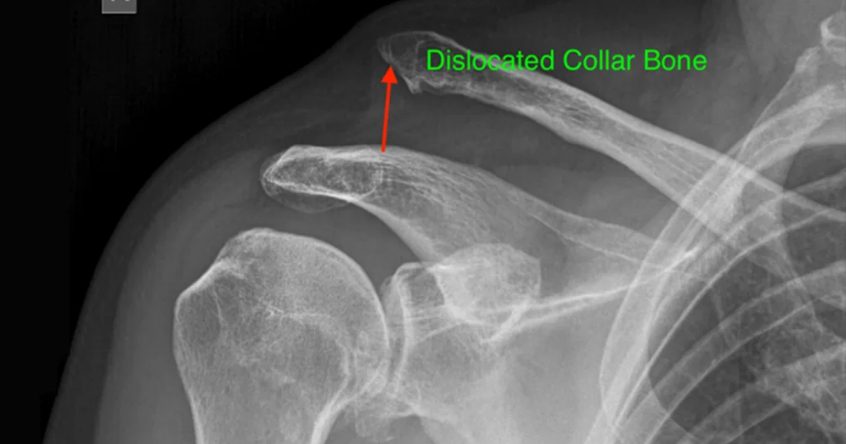Shoulder Injuries
Clavicle fracture
The clavicle or “collarbone” is a curved bone that connects the sternum or upper part of the breastbone to the acromion (a part of the shoulder blade). It is a superficial bone that lies just under the skin. It has many muscle attachments. It acts as a strut that supports the shoulder and shoulder blade during movement.
The clavicle is one of the most common bones to break or fracture. It occurs in children and accounts for about 5% of adult fractures. It usually results from a fall on the shoulder or on the outstretched arm, which transmits the forces back to the clavicle. Fractured collarbones are a common cycling injury and occur both with road and mountain biking. The fractures can be simple where the broken bone is in two pieces or comminuted where there is more than one fracture line, and the bone has multiple (three or more) parts.

Treatment
Many clavicle fractures can be treated satisfactorily without surgery. The arm is placed in a sling to protect the collarbone if the bones are not widely separated. A sling may be required for up to six weeks. Gentle movement may be allowed after the initial pain has settled, which usually occurs in the first two weeks.
Physiotherapy may be required to facilitate shoulder movement and, in the later phase of healing, to help restore strength. Most clavicle breaks heal satisfactorily. Loss of the natural contour the collarbone may be present if the fracture was displaced. Where healing has occurred, a bony prominence may be visible or easily felt. However, shoulder function typically returns to normal.

Surgery is the better option for two types of fracture patterns. Firstly, a fracture in the mid clavicle that is widely displaced or is in several pieces or both. Often the clavicle can be significantly shortened with an overlap of the bones. The second fracture pattern is one that occurs at the outer end of the collarbone. These are often associated with ligament damage that causes displacement of the bone fragments with a reduced chance of healing.
Surgery for clavicle fractures involves putting the bones back together and holding them with a unique plate and screws. After the surgery, the arm is in a sling for comfort, but early movement is permitted.
The benefits of surgery for these specific fracture types are quicker return to full movement and function. It may allow people to return to work earlier. There is also a higher chance of the bones uniting or knitting together with surgery. As the clavicle sits just below the skin, in some people the plate and screws may be prominent and be uncomfortable with the pressure of straps, seat belts etc. Discomfort from pressure might require removal of the metalware.
The benefits of surgery for these specific fracture types are quicker return to full movement and function. It may allow people to return to work earlier.
Call us on (03) 5223 3151 Book an appointment today.
Acromioclavicular joint injuries
As mentioned above, the outer end of the clavicle forms a joint with the acromion, the acromioclavicular (AC) joint. Two strong ligaments that connect the collarbone to another part of the shoulder blade called the coracoid process reinforce the joint. The ligaments are the coracoclavicular (CC) ligaments. The AC joint can be damaged by a fall directly onto the point of the shoulder. The injury can vary in severity. A mild injury involves a sprain of the joint. A moderate injury is where there is more extensive damage, and the joint is partly displaced. A severe injury is where the CC ligaments tear completely and the AC joint separates (or dislocates). A significant step between the collarbone and the acromion is easily visible.
Treatment
Mild and moderate injuries can be treated adequately with a period of rest. The arm is immobilised in a sling initially. Early range of movement is encouraged, followed by a strengthening program. Depending on the severity, the recovery may take from weeks to months. Sports are allowed when there is a full pain-free range of movement of the shoulder.
Severe injuries may require surgery. At surgery, the joint is reduced then held with tapes that secure the collarbone to the coracoid process. Following fixation, the arm is in a sling for two to six weeks. Shoulder movement is then allowed.
Occasionally AC joint injuries managed nonoperatively are painful. An AC joint reconstruction may be necessary. The repair involves removing a small part of the end of the clavicle then holding down the collarbone with a tendon graft.
Fractures of the upper arm
Fractures of the upper arm, adjacent to the shoulder, are also relatively common, especially in older patients. These can be simple fractures. However, in older adults with soft bone, they can be more complex with multiple fragments. In severe cases, there may be displacement of the pieces or the fracture may split the head of the arm bone. Occasionally the fracture is associated with a dislocation of the shoulder joint.
Treatment
Nonoperative management is suitable for most of these fractures. A collar’n’cuff sling supports the shoulder. When comfort permits, shoulder movement is commenced. This type of fracture usually heals satisfactorily, but reduced shoulder movement frequently occurs.
However, a minority of these fractures require surgery. In younger people with displaced fractures, surgery may have a role. In these younger patients, the break is reduced and held with specially designed plates. Displaced fractures in older people need alternative treatment as the bone is often too soft and in too many parts to fix adequately. For this group of patients, a reverse shoulder replacement is the preferred treatment.

